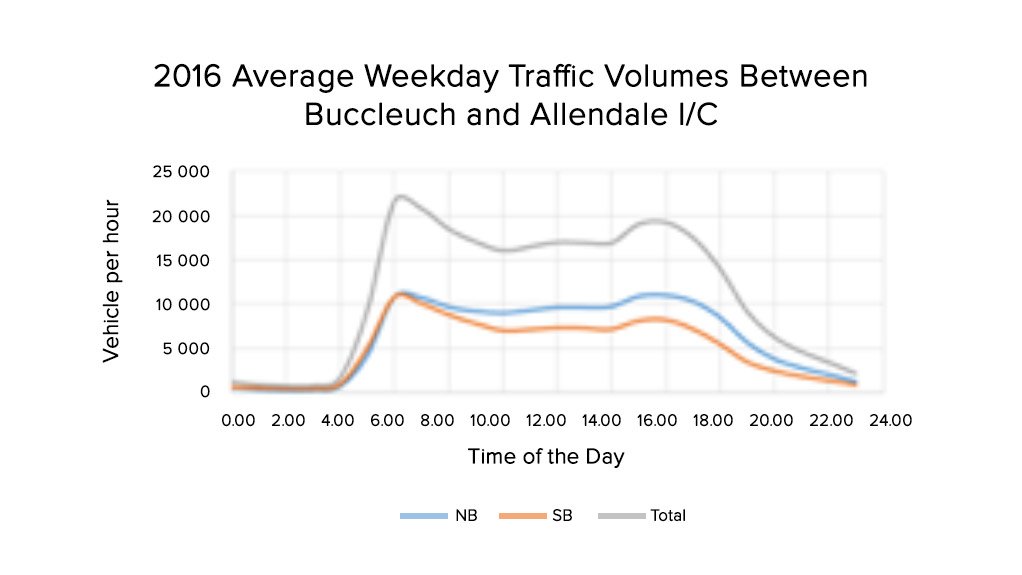The busiest section of the Gauteng open-road tolling (GORT) system is between the Buccleuch and Allandale interchanges, in Midrand.
The traffic volume in both directions in 2016 reached 245 500 vehicles a day during the week, on average, says South African National Roads Agency Limited (Sanral) communications GM Vusi Mona.
During the morning and afternoon peaks volumes on the freeway reached between 10 000 and 11 000 vehicles an hour in each direction, he adds.
This is an almost 100% increase from 2006, when the average peak volumes between the Buccleuch and Allandale interchanges were between 5 000 and 6 400 vehicles an hour in the off-peak and peak directions, respectively.
Mona says the upgrading and expansion of the Gauteng freeway network, post 2006, has allowed for normal traffic growth, accommodating the roughly 4.7% increase in yearly traffic seen since 2010.
However, today the GORT system is close to capacity, he notes.
Around 133 000 vehicles an hour enter and leave the GORT network each hour during peak periods.
With an average of 1.2 people per vehicle, the network carries almost two-million-person trips a day, says Mona.
The morning peak period is between 06:00 and 09:00 and the afternoon between 15:00 and 18:00. However, Sanral has noticed that there is not much of a reduction in traffic volumes between the morning and afternoon peaks.
The growth in traffic demand results in the peak periods being extended by around 15 minutes a year, notes Mona.
“During the peak periods, many of the freeway sections carrying the peak direction demands are running at capacity – actually over the design capacity.
“There is only spare capacity on the off-peak directions and some limited spare capacity on sections of the N12 south of Johannesburg, as well as sections of the R21 during the peaks.
“There is some spare capacity during the off-peaks, but this is reducing as traffic demand increases.
“When the freeways are operating at these volumes, travel times become unpredictable as the slightest incident can cause considerable delays.”
Mona says traffic demand in Gauteng is predicted to continue to increase to 2020, which will have a detrimental effect on travel times. (Statistics show that Gauteng faces large-scale urbanisation pressure. Around 547 people arrive in the province every day.)
While the average travel times during the peaks may not increase, the peak periods will get longer.
The average daily traffic on normal weekdays between the Buccleuch and Allandale interchanges may increase to around 285 000 vehicles a day by 2020, says Mona. Currently, the highest day volumes have been measured at 283 000 vehicles.
The traffic predictions made before the implementation of open-road tolling anticipated that congestion levels and associated travel speeds for some of the freeway sections would revert to 2007 levels – before the additional lanes were added to the Gauteng freeway system – by 2017/18.
“The predicted traffic growth is unfortunately materialising and increased congestion and delays are experienced on sections of the GORT,” notes Mona.
“Essentially the average travel time could increase by ten minutes between now and 2020, but will increase exponentially from then onwards.”
Data Mine
For June 2017, unaudited data shows that the GORT system captured 79.32-million transactions at the various gantries for vehicles that were registered for e-tolls and those that were not.
“From our system we can report for a typical month (in this case, June) that we have 1-million vehicles registered that are in good standing, paying and active, with 2.17-million vehicles that are not registered, or not in good standing,” says Mona.
Around 70% of e-toll transactions were unpaid in June.
The number of transactions or vehicle records varies due to the number of weekdays, special events and public holidays in any particular month.
Apart from calculating the applicable tariff, the data collected at the gantries can also be used to provide information on traffic conditions such as speeding, congestion and periods of congestion; to determine traffic patterns along the network; for traffic modelling and transport planning purposes and to determine the time and location of a particular vehicle on the toll network.
The data is also used by law enforcement agencies as part of their investigative processes, such as in the case of accidents and criminal behaviour.
Although the system can calculate average speed over distance, it has not yet been used to determine speed infringements, says Mona.
Stationary Vehicles
GORT system statistics show that there were 13 093 stationary vehicles on the freeway system during 2016, with 4 403 of these heavy vehicles.
Thirty-eight of these stationary vehicles resulted in accidents, with ten of these heavy vehicles.
Sanral’s Incident Management System is focused on the early detection and effective management of all incidents, including accidents and broken-down vehicles.
“Our records show a decrease of more than 30% in the overall incident management time-line,” says Mona.
The overall incident management time-line reflects the time it takes from when an incident occurred until normal traffic flow has been restored.
EMAIL THIS ARTICLE SAVE THIS ARTICLE ARTICLE ENQUIRY
To subscribe email subscriptions@creamermedia.co.za or click here
To advertise email advertising@creamermedia.co.za or click here













